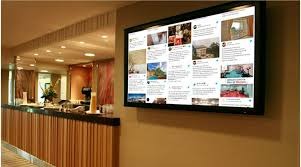The hospitality industry has undergone a significant transformation with the integration of digital technology, particularly through the use of hotel signage. It’s a dynamic and engaging way to communicate with guests, offering an interactive and informative experience. For hotels and venues aspiring to elevate their guest services, understanding and implementing best practices for digital signage is essential.
Understand the Role of Digital Signage in Hospitality
Hotel digital signage is more than just an electronic display; it is a crucial tool for enhancing guest experiences, operational efficiency, and branding. The placement, content, and functionality of digital signs need to be strategically planned to maximise their effectiveness. This extends from welcoming guests at the lobby to providing wayfinding solutions and event information.
Strategic Placement for Maximum Impact
Choosing the right location for your digital signage is fundamental. High-traffic areas such as lobbies, elevators, and conference spaces are prime spots. These signs should be visible and positioned at eye-level where they can attract attention and provide utility.
Content is King: Tailoring Messaging to Your Audience
Content on digital signage should be relevant, engaging, and tailored to the audience. For hotels, this includes information on amenities, local attractions, and special events. It is also an opportunity to promote services such as spas, restaurants, or exclusive offers.
Interactivity Enhances Guest Engagement
The introduction of interactive digital signage has revolutionised guest interaction in hotels. By incorporating touchscreens, guests can navigate hotel maps, explore services, and even make reservations seamlessly.
Designing for Clarity and Consistency
Both the visual design and user interface of digital signage should be clean and consistent with the hotel’s brand image. Text should be easy to read, and the overall layout must allow for straightforward navigation of content. Consistency ensures that guests receive the same brand message and experience throughout their stay.
Digital Signage as a Wayfinding Tool
Wayfinding is one of the most practical applications of hotel signage. Interactive screens can help guide guests to their desired locations within the hotel, reducing confusion and improving their overall experience.
Dynamic Content for a Dynamic Environment
Hotel digital signage content should not be static. It needs to be updated frequently to reflect the most current information and offers. This dynamic nature of digital content facilitates the promotion of time-sensitive deals and events, keeping guests informed and engaged.
Leveraging High-Quality Visuals on Digital LED Screens
Digital LED screens are a powerful medium for visual storytelling in the hospitality sector. These high-definition displays can showcase stunning visuals of the hotel’s amenities or beautiful local scenery, captivating guests and enhancing the aesthetics of the space.
Integrating Social Media and User-Generated Content
Encouraging guest interaction through social media feeds on digital signs can create a sense of community and real-time engagement. User-generated content, such as reviews and photos, can be showcased to build trust and offer a personalised experience.
Ensuring Accessibility for All Guests
It’s important to consider accessibility when designing digital signage content. This includes high-contrast visuals for the visually impaired and assistive technologies for those with other disabilities. By making digital signage accessible, hotels ensure inclusivity for all guests.
Training Staff and Leveraging Analytics
Hotel staff should be well-versed in how the digital signage system operates to assist guests when required. Additionally, leveraging analytics from digital signs can provide valuable insights into guest interests and interactions, enabling hotels to refine their offerings and messaging.
Regular Maintenance and Updates
Digital signs require regular maintenance to prevent any technical issues that could disrupt the guest experience. Software and content updates are especially critical to keeping the system running smoothly and ensuring the information presented is up-to-date.
Future-Proofing with Scalable Solutions
Investing in scalable digital signage solutions is wise as it allows for easy updates and expansions in the future. As the hotel grows or technology evolves, the digital signage system should adapt and maintain its effectiveness.
Conclusion
Effective hotel digital signage can significantly enhance guest experiences and streamline hotel operations. By following best practices such as strategic placement, engaging content, interactive features, and regular maintenance, hotels can leverage digital signage as a powerful tool for communication and branding. As the hospitality industry continues to embrace digital solutions, staying abreast of these practices becomes ever more critical to standing out in a competitive market.
Implementing the well-established strategies outlined in this article will not only delight guests but also provide a compelling return on investment for hotels looking to lead in the digital age.







